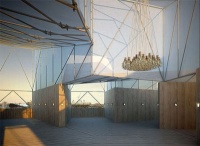A more exciting retail space is popping up
While retail interiors of the 1990s could be overly reverent, Carolyn Burke argues that stores became a lot more fun in the Noughties
Traditionally, the types of interiors in which we eat, drink, shop and relax in London have tended to reflect a more conservative side of design. But it’s interesting to observe how interiors reflect our social values, if not form them.
The opportunity has now arisen though to balance London’s repertoire of interiors, which means that designers and businesses are finding new, innovative ways to inhabit the capital. We’re seeing ephemera like speakeasies, supper clubs, pop-up shops and even pop-up hotels mushrooming around us. With this we start to see the use of materials that are afforded no place in our more conservative establishments. Happily, the interiors are often collaborations involving artists, charities, architects and chefs. The ubiquitous interior-designed space is side-stepped neatly.
Yes, it’s all fashionable and playful, but it is also a simplified and natural way of enlivening London’s disused spaces. Services and products are often locally sourced, reused, borrowed and recyclable. These ventures are becoming more exciting and will, hopefully, start to create new ways for retailers and restaurateurs to respond quickly to what Londoners want and need.
I recently read about an American restaurant that has opened, Kubideh Kitchen, which proposes to change its cuisine every four months to serve food whose country of origin is a nation in conflict with the US. It aims to increase social dialogue on conflict – it would be great to see this sort of thing find a voice in London.
Londoners seem to have long since tired of the design-led interiors of the 1990s and early Noughties. A decade ago London’s interiors were typified by the anorexic arch-simplicity of the barely-there age of minimalism. John Pawson’s Jigsaw shop in Chelsea felt like a church and the staff were aloof and reverent. A friend of mine shopped in Comme de Garçons in the 1990s and fondly recalls sales assistants completely ignoring their customers. And is it my foggy memory or did the Hempel Hotel burn incense?
The Noughties have lived up to their name. We have definitely had more fun. Like music and fashion, the design industry positively revels in flamboyance and knowingly embraces tongue-in-cheek chic. Karl Lagerfeld spotted the marketing value of this and relaxed his strict views on weight and beauty by showing fleshier (and presumably happier) models on the Chanel catwalks. He recently dressed burlesque dancer Miss Dirty Martini and, as one blogger put it, ’The very iconic and idealised foundation of fashion has seemingly been reduced to the paltry, sweaty and excreting world of brothels and lustful distaste, all hail…’
London’s interiors, however, no longer flash their design aspirations around. In fact, they seem to be the equivalent of made-to-look-old T-shirts. We’ve let our belts out and settled into an atmosphere that’s welcoming, cosy and comfortable. There’s been a ’design’ backlash. We all love the interiors of Martin Brudnizki and David Collins, but, when I go out to places like Dean Street Townhouse, Hix, Scott’s or any of London’s other exclusive restaurants and bars, I’m strangely reminded of an upmarket Harvester pub. It’s usually the expensive contemporary art on the walls that saves them. They are perfect places though for a whisky sour.
Celebrating the turn of the millennium, I imagined as designers we would be pushing the envelope with eco-interiors and that technology would be incorporated dramatically into our work. I thought there would be seismic shifts in how we use spaces and finishes. In 1999, Rem Koolhaas’ seminal retail experiment with Prada seemed to herald a socially cognisant and diverse technological future. Potentially blurring the way we used retail spaces, he incorporated spaces for exhibitions, lectures and digitised shopping. This never really caught on. The shop now stands on Mercer Street, almost a museum-piece reminding us of a long-forgotten time. Indeed, with our public buildings Greenwashing has been shamefully rife. It’s been difficult for most clients to see the value in investing in sustainable products, particularly when as a society we have had no appetite for them. We have not wanted interiors that reflect the aesthetics of the ecological or of technology.
It’s exciting to see how interiors have started evolving in a way that can have an impact on our lives in a simpler way than expected. There will always be the stalwarts of comfort in London, but the exciting thing about the recent economic downturn may be that it is now wide open for anyone to deliver more meaningful and socially aware spaces that aren’t solely devoted to our comfort or style sensibilities.
Fingers crossed for a temporary spa to open for the summer. Preferably, it will be located around the corner from my house – and on a rooftop. I’d do it myself if I wasn’t so busy. Meanwhile, another whisky sour please.
Catch them while you can

- Studio East Dining (pictured), a temporary restaurant open from 16 June to 4 July on top of Westfield Stratford City, above the Olympic Park
- Giles Miller has designed a pop-up shop for Stella McCartney in Paris. It is open until the end of this month
- Puma will be touring the UK in July in a pop-out shop, a customised lorry that showcases the Puma archive
-
Post a comment




